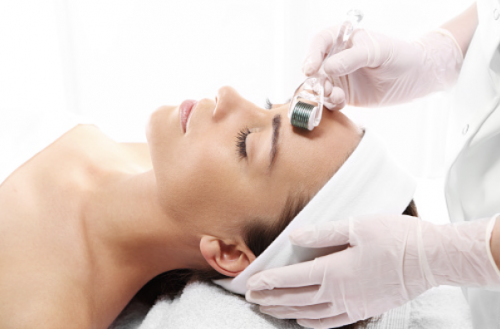
Microneedling is a non-invasive treatment that uses tiny needles to puncture the skin regularly. The puncturing creates small holes in the epidermis and dermis layer, allowing the skin to absorb more collagen and elastin that occurs naturally in the body, resulting in younger-looking skin. Dermaplaning removes dead skin cells on your face by using small blades to scrape off the uppermost layer of skin cells, leaving you with clearer and smoother-looking skin.
What is Microneedling?
Microneedling is a minimally invasive skin treatment that involves creating tiny, microscopic wounds in your skin using a device with multiple fine needles. These small wounds trigger your body’s natural healing process to stimulate collagen production, which helps reduce wrinkles and scars. It is also known as derma roller or micro-needling.
What is the procedure of Microneedling?
The Microneedling procedure is done in two steps.
Step 1: A topical anaesthetic cream is applied to numb your skin if you choose to have it numbed. Next, a hand-held device with multiple fine needles is rolled across your face in various directions.
It creates tiny wounds in your skin that allow for increased absorption of serums and creams applied after treatment.
Step 2: After your skin has been treated, serum or cream is applied to your face. The best part about Microneedling is that You can do it independently, but you can also combine it with other procedures such as laser resurfacing or chemical peels.
It’s also great for treating acne scars, stretch marks, fine lines and wrinkles.
Benefits of Microneedling
Microneedling has many benefits. First of all, It is safe. Microneedling improves skin texture and reduces fine lines and wrinkles. It also promotes collagen production.
Microneedling can be used on all skin types and colours. And it’s quick! A single treatment takes about 15 minutes to perform.
There is no downtime after a Microneedling; you can return to work or school immediately after your treatment session. The results of Microneedling last for up to six months; however, some patients experience longer-lasting results.
How long does it take to heal after a micro-needling treatment?
Microneedling procedures take approximately half an hour to complete. You may feel some slight redness in your skin for about two hours following your treatment, but other than that, you should be able to resume your daily activities with no restrictions.
Your face may look redder than usual for up to 24 hours after a micro-needling session. Additionally, you may experience some minor itching or stinging. These sensations subside within a day or two of your procedure.
You should be able to resume normal activities immediately after treatment. You can wash your face gently with warm water when you get home from your appointment. It’s also important to keep an eye on any new blemishes that appear in the days after treatment—if there are any pop-ups, treat them with over-the-counter acne medication.
What is Dermaplaning
Many people have become familiar with Dermaplaning over the past few years. Still, not many are aware of what it entails and the benefits of undergoing this procedure.
Dermaplaning is simply shaving off dead skin cells on the surface of your face that can appear dull or aged, revealing fresher and younger-looking skin underneath that can restore your overall complexion.
What is a Dermaplane treatment?
Dermaplaning is a non-invasive cosmetic procedure that exfoliates your skin by removing dead skin cells, peach fuzz, and vellus hair with a scalpel. This treatment can benefit all skin types, but it is especially helpful for those of us with sensitive or acne-prone skin.
Dermaplane treatments help get rid of pesky blackheads and whiteheads by removing debris on your pores’ surface, which causes them to clog. Skin feels smoother and more even without makeup after dermaplaning!
Benefits of Dermaplaning
There are many benefits of dermaplaning, including reducing fine lines, acne scars, uneven skin tone, and hyperpigmentation. The process is also said to stimulate collagen production. For those with sensitive skin or who have been using retinol products for a while without seeing results, dermaplaning may be able to help.
While you should always consult your dermatologist before beginning any new skincare regimen, dermaplaning is a treatment that can be done in an office setting by a licensed professional. It’s important to note that dermaplaning is not a substitute for exfoliation or chemical peels; rather, it’s meant to complement these treatments
Your skin will appear smoother after one session of dermaplaning, but it takes about three weeks for collagen production to kick into high gear. You should plan on a series of treatments to see significant results.
It’s also important to note that not everyone is a good candidate for dermaplaning; if you have active acne or rosacea, you may not be able to undergo treatment until your condition has improved.
Things To Know Before Starting A Skin Care Regimen
There are various things to know before starting any skincare regimen. One aspect that is often overlooked is dermaplaning. It is an exfoliation technique that uses a dull razor to remove dead skin cells from your face.
By eliminating these extra cells, you can allow new skin to come through, making it look more vibrant and youthful. This technique is a great way to achieve a baby-soft complexion without spending time in a dermatologist’s office.
It’s also much less expensive than other exfoliation methods such as microdermabrasion or chemical peels.
Interesting Related Article: “How Does Someone Get Rid Of Severe Acne Scarring?“

